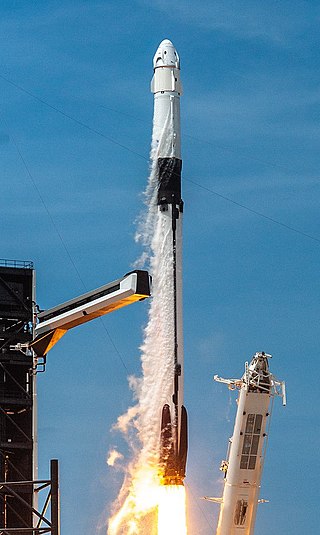
The Scout family of rockets were American launch vehicles designed to place small satellites into orbit around the Earth. The Scout multistage rocket was the first orbital launch vehicle to be entirely composed of solid fuel stages. It was also the only vehicle of that type until the successful launch of the Japanese Lambda 4S in 1970.

Minotaur-C,formerly known as Taurus or Taurus XL,is a four stage solid fueled launch vehicle built in the United States by Orbital Sciences and launched from SLC-576E at California's Vandenberg Air Force Base. It is based on the air-launched Pegasus rocket from the same manufacturer,utilizing a "zeroth stage" in place of an airplane. The Minotaur-C is able to carry a maximum payload of around 1458 kg into a low Earth orbit (LEO).

The Minotaur is a family of United States solid-fuel launch vehicles repurposed from retired Minuteman and Peacekeeper model intercontinental ballistic missiles. Built by Northrop Grumman under the Space Force's Rocket Systems Launch Program,these vehicles are used for various space and test launch missions.

Atlas is a family of US missiles and space launch vehicles that originated with the SM-65 Atlas. The Atlas intercontinental ballistic missile (ICBM) program was initiated in the late 1950s under the Convair Division of General Dynamics. Atlas was a liquid propellant rocket burning RP-1 kerosene fuel with liquid oxygen in three engines configured in an unusual "stage-and-a-half" or "parallel staging" design:two outboard booster engines were jettisoned along with supporting structures during ascent,while the center sustainer engine,propellant tanks and other structural elements remained connected through propellant depletion and engine shutdown.

Antares,known during early development as Taurus II,is an American expendable medium-lift launch vehicle developed and built by Orbital Sciences Corporation with financial support from NASA under the Commercial Orbital Transportation Services (COTS) program awarded in February 2008,alongside the company's automated cargo spacecraft,Cygnus. Like other launch vehicles developed by Orbital,Antares leveraged lower-cost,off-the-shelf parts and designs.

This comparison of orbital launch systems lists the attributes of all current and future individual rocket configurations designed to reach orbit. A first list contains rockets that are operational or have attempted an orbital flight attempt as of 2024;a second list includes all upcoming rockets. For the simple list of all conventional launcher families,see:Comparison of orbital launchers families. For the list of predominantly solid-fueled orbital launch systems,see:Comparison of solid-fueled orbital launch systems.
Scout X-2 was an American expendable launch system and sounding rocket which was flown twice in 1962. It was a four-stage rocket,based on the earlier Scout X-1,uprated first and third stages. It was a member of the Scout family of rockets.

The Altair was a solid-fuel rocket with a fiberglass casing,initially developed for use as the third stage of Vanguard rockets in 1959. It was manufactured by Allegany Ballistics Laboratory (ABL) as the X-248. It was also sometimes called the Burner 1.
The Atlas E/F was an American expendable launch system and sounding rocket built using parts of decommissioned SM-65 Atlas missiles. It was a member of the Atlas family of rockets.
The Atlas SLV-3,or SLV-3 Atlas was an American expendable launch system derived from the SM-65 Atlas / SM-65D Atlas missile. It was a member of the Atlas family of rockets.

Scout X-1 was an American expendable launch system and sounding rocket which was flown seven times between August 1960 and October 1961. Four orbital and three suborbital launches were made,with four of the launches resulting in failures.

The RM-89 Blue Scout I was an American sounding rocket which was flown four times between January 1961 and April 1962. It was used for two HETS test flights,and a flight to investigate atmospheric re-entry. It was a member of the Scout family of rockets.
Scout X-1A was an American sounding rocket which was flown in 1962. It was a five-stage derivative of the earlier Scout X-1,with an uprated first stage,and a NOTS-17 upper stage.

Scout X-2M was an American expendable launch system which was flown three times between May 1962 and April 1963. It was a four-stage rocket,based on the earlier Scout X-2,but with an MG-18 upper stage instead of the Altair used on the X-2. It was a member of the Scout family of rockets.
The Scout X-2B was an American expendable launch system which was flown during 1963. It was a four-stage rocket,based on the earlier Scout X-2,but with an Altair 2A fourth stage in place of the Altair 1A used on the X-2. It was a member of the Scout family of rockets.

This article compares different orbital launcher families. The article is organized into two tables:the first contains a list of currently active and under-development launcher families,while the second contains a list of retired launcher families.
The Star is a family of US solid-propellant rocket motors originally developed by Thiokol and used by many space propulsion and launch vehicle stages. They are used almost exclusively as an upper stage,often as an apogee kick motor. The number designations refer to the approximate diameter of the fuel casing in inches.

The Algol family of solid-fuel rocket stages and boosters is built by Aerojet and used on a variety of launch vehicles. It was developed by Aerojet from the earlier Jupiter Senior and the Navy Polaris programs. Upgrades to the Algol motor occurred from 1960 until the retirement of the Scout launch vehicle in 1994.
A medium-lift launch vehicle (MLV) is a rocket launch vehicle that is capable of lifting between 2,000 to 20,000 kg by NASA classification or between 5,000 to 20,000 kilograms by Russian classification of payload into low Earth orbit (LEO). An MLV is between small-lift launch vehicles and heavy-lift launch vehicles.

A small-lift launch vehicle is a rocket orbital launch vehicle that is capable of lifting 2,000 kilograms (4,400 lb) or less or under 5,000 kilograms (11,000 lb) of payload into low Earth orbit (LEO). The next larger category consists of medium-lift launch vehicles.












